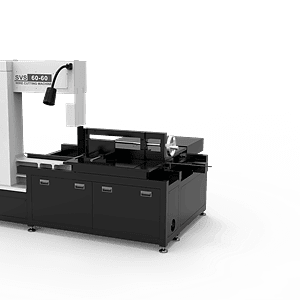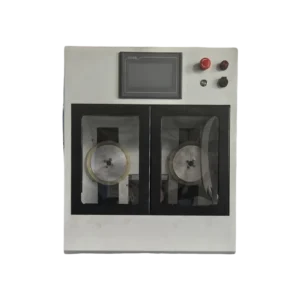Diamond Wire Saws
Industrial Diamond Wire Saws for Precision Slicing
What Are Diamond Wire Saws?
A diamond wire saw is a precision cutting machine that uses a diamond-abrasive wire as the cutting tool.
The wire—typically made from a high-strength steel core coated with diamond particles—cuts by abrasive grinding, allowing it to process hard, brittle, and high-value materials that are difficult to machine with conventional blades.
Diamond wire saws rely on a continuous wire running between multiple guide wheels. As the wire moves at high linear speed, the embedded diamond particles remove material through micro-grinding. This cutting principle provides:
Very narrow kerf width
Reduced cutting forces
Lower material stress
Cleaner, smoother surfaces
Compatibility with fragile or crystalline materials
Diamond wire saws are widely used in semiconductor materials, optics, ceramics, graphite, stone, and composite materials, where precision and low damage are essential.
Types of Diamond Wire Saws
Diamond wire saws can be classified into two primary categories based on their drive mechanism and wire configuration.
1. Reciprocating Diamond Wire Saw
These systems use a long-length wire, typically 200 m to 30 km, wound on a spool.
The wire travels in a back-and-forth motion, requiring reversing direction during operation.
Characteristics:
Large cutting quantity with multi-wire design
Wire tension and motion reversal introduce minor vibration
Common in photovoltaic silicon slicing and large-scale stone cutting
Requires periodic wire rewinding and tension adjustments
Typical Applications:
Solar-grade silicon wafers
Stone slabs
2. Continuous Diamond Wire Loop Saw
A circular, closed-loop diamond wire of 2–10 m is mounted on the machine without the need for reversing.
Unlike traditional reciprocating wire saws, endless diamond wire saws operate in a single continuous direction, eliminating vibration and achieving superior cutting accuracy.
Characteristics:
Short wire length
Stable single-direction motion
Suitable for compact, high-precision cutting systems
Supports contour cutting and small-part slicing
- Faster linear speed (80m/s)
Typical Applications:
Optical glass
Ceramics
Sapphire components
Precision graphite parts
Key Technologies in Endless Diamond Wire Saws
1. Endless Loop Design
No reversing motion
Uniform abrasive engagement
Lower vibration amplitude (<3 μm)
Longer tool life compared to long-length wires
2. High Wire Speed (60–80 m/s)
High linear velocity produces clean, fine surfaces with minimal cutting marks.
3. Constant Tension Control
Servo-regulated tension ensures smooth wire engagement and prevents micro-cracks in brittle materials.
4. Cold Cutting Process
Low thermal load avoids:
Optical coating delamination
Thermal stress
Surface discoloration
Micro-fracture zones in ceramics or sapphire
Applications Across High-Value Materials
Applications of Diamond Wire
Silicon & Semiconductor Materials
Low-damage slicing for research wafers
Suitable for thick ingots and brittle structures
Sapphire & Optical Crystals
Ideal for LED substrates, optical components, windows
Smooth surface with minimal edge chipping
Optical & Coated Glass
Excellent for multilayer coated optics, filters, diffusers
Cold cutting avoids coating burns or peeling
Graphite & Carbon Materials
High removal rate with stable surface finish
Multi-wire options available for volume production
Ceramics & Carbides
Compatible with alumina, zirconia, SiC
Reduces micro-crack depth and improves dimensional accuracy
Magnetic Materials (NdFeB / Ferrite)
Suitable for slicing NdFeB, SmCo, and ferrite blocks
Stable wire engagement prevents edge chipping and magnet cracking
Ideal for precision cutting of small magnet pieces or multi-block arrays
Loop Diamond Wire Saw Models
Ultra-huge Diamond WIre Saw
- Max Workpiece Length (mm): 2500
- Max Workpiece Width (mm): 800
- Max Workpiece Height (mm): 800
Best Seller Graphite Wire Saw
- Max Workpiece Length (mm): 800
- Max Workpiece Width (mm): 800
- Max Workpiece Height (mm): 800
Multi Wire Saw
- Max Workpiece Length (mm): 600
- Max Workpiece Width (mm): 600
- Max Workpiece Height (mm): 600
Entry-Level Wire Cutting Machine
- Max Workpiece Length (mm): 600
- Max Workpiece Width (mm): No limit
- Max Workpiece Height (mm):600
CNC Interal Contour Cutting Machine
- Max Workpiece Length (mm): 200
- Max Workpiece Width (mm): 200
- Max Workpiece Height (mm):200
3D TAPER CUT ENDLESS DIAMOND WIRE SAW MACHINE
- Max Workpiece Length (mm):600
- Max Workpiece Width (mm):600
- Max Workpiece Height (mm):600
Benchtop CNC Diamond Wire Saw
- Max Workpiece Length (mm): 150
- Max Workpiece width (mm): 150
- Max Workpiece Height (mm): 150
Each model supports adjustable feed rate, tension monitoring, and customizable fixtures (magnetic base, vacuum table, or custom jigs).
Videos of Different Electroplated Diamond Wire
Playlist
0:16
0:16
0:16



Frequently Asked Questions (FAQ)
Q1. What is the difference between traditional diamond wire saws and endless wire saws?
Traditional diamond wire saws normally has a multi-wire structure to cut same product with a large quantity, endless wire saw normally has a single wire structure which can cut different product type such as complex contour, 3D shape or other precision products.
Q2. How long does the endless diamond wire last?
Typically 30–100 hours, depending on material hardness, coolant flow, and feed pressure.
Q3. Can the same diamond wire be used for all materials?
No. Wire diameter and grit size must be matched to the material:
0.3 mm for brittle material.
0.4–0.6 mm for ceramics or composites
- 0.6-0.8 for graphite.
Q4. What coolant do you recommend?
White cutting oil for crystal glasses and metals; water-based coolant for certain material; city water also acceptable if the material requires.
Q5. What surface quality can be achieved?
Ra 1–2 μm, depending on wire diameter, grit size, and feed rate.
Q6. What maintenance is required?
Daily cleaning, regular guide wheel inspection, tension calibration, and wire replacement once abrasive degradation appears.







